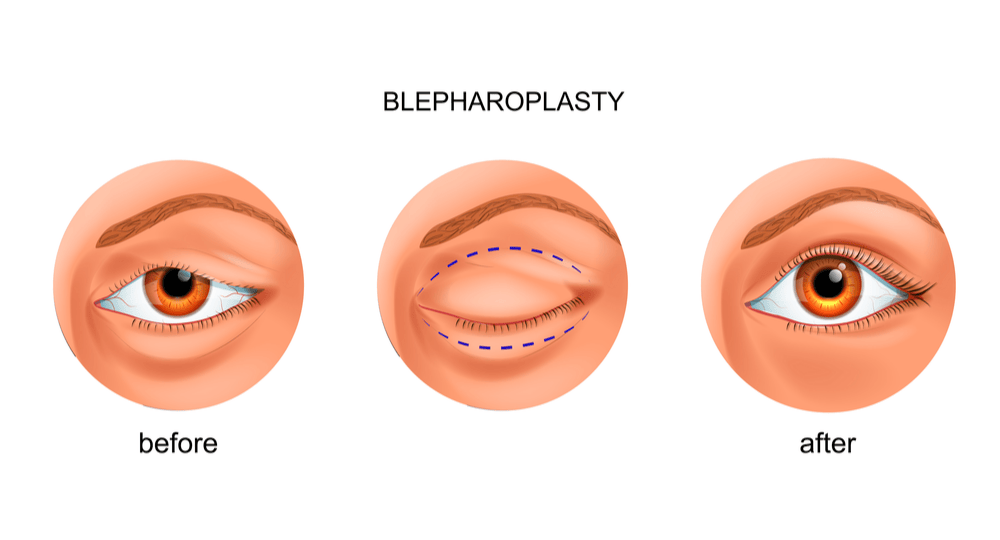Blepharoplasty: What is Eyelid Lift Surgery?
Blepharoplasty, also known as eyelid lift surgery, is a cosmetic surgery to improve the appearance of the eyelids.
While eyelid surgery is a relatively common cosmetic procedure, choosing to have any cosmetic surgery is a big decision, and it is important to research the treatment first before committing to surgery.
That’s why we’ve created this blepharoplasty guide — so that you can learn more about this surgery, how it works, recovery, risks and anything else you need to know to establish whether it is the right path for you.
What is blepharoplasty (eyelid surgery)?
Blepharoplasty, is a surgical procedure used to improve the appearance of the eyelids.
As we get older, our skin becomes less elastic, and gravity causes drooping. In particular, the soft tissue made up of skin and fat that surrounds our eyes starts to droop. This can create sagging, undefined or tired-looking eyelids and bags under the eyes.
Blepharoplasty is a procedure that works to tighten this soft tissue and remove any excess skin and fat — rejuvenating the area around your eyes and resulting in brighter, more alert and open eyes.
The procedure can be carried out on the upper or lower eyelids, or both.
The blepharoplasty procedure
The blepharoplasty procedure is usually carried out under general anaesthetic, though it can be performed under a local anaesthetic, which is injected into the eyelids. It typically takes between one and two hours.
There are two types of blepharoplasty:
- Upper blepharoplasty
- Lower blepharoplasty
Upper blepharoplasty
Upper blepharoplasty focuses on the upper eyelids — the region between the eyelashes and eyebrows.
During the upper blepharoplasty procedure, your surgeon will:
- Make a cut (incision) along the eyelid crease (in the natural fold of the eyelid)
- Remove any excess skin or fat that is pushing through the muscle
- Close the incision using very fine stitches
The scar you have from the incision will typically be hidden in the natural fold of the eyelid, so it won’t be visible. You should be able to go home the day after upper blepharoplasty surgery.

Lower blepharoplasty
Lower blepharoplasty, surgery on the lower eyelids, is a slightly more complicated procedure that usually involves improving the appearance of bags under the eyes.
During lower blepharoplasty, your surgeon will:
- Make a small incision along the border of your eyelid — either inside your lower eyelid or below your lower eyelash line to just beyond the outside edge of your eye
- Remove or redistribute any excess fat from bags under the eyes (sometimes, this also includes a small amount of skin)
- Support the muscles and tendons of the eyelid if necessary
- Close the incision using either removable sutures or glue
In some cases, your surgeon may recommend that you stay overnight after having lower blepharoplasty, but this is something that you will discuss together in the time leading up to the procedure.
Blepharoplasty recovery
After blepharoplasty, you will spend some time in a recovery room, where you will be monitored for complications. Usually, you will be able to go home later that day. You will need to come back around a week later to have any stitches removed.
After surgery, you may temporarily experience:
- Some blurred vision (from the ointment applied to your eyes before surgery)
- Puffy and numb eyelids
- Light sensitivity
- Watery eyes
- Moderate swelling and bruising
- Some pain or discomfort
These post-surgery side effects are normal and will subside in time.
To help with blepharoplasty recovery, your surgeon may recommend:
- Keeping your head upright for a few days, when resting or sleeping (you can prop your head up with pillows)
- Gently clean your eyes and eyelids as advised
- Use cool compresses or ice packs on your eyes for the first few days to ease swelling
- Wearing sunglasses to protect your eyes from sun and wind
- Using only the medication you are given to relieve any pain
- Avoiding certain activities, heavy lifting and strenuous exercise (particularly swimming) for a week after surgery
- Avoiding driving for a few days after your operation
- Avoiding smoking (smoke can irritate the eyes)
- Avoiding rubbing your eyes or the use of contact lenses
Blepharoplasty recovery varies for everyone, but you should be able to return to work after a week if you have had upper blepharoplasty. If you’ve had lower blepharoplasty or surgery on both eyelids, it may take slightly longer — around two to three weeks.
Blepharoplasty risks
Blepharoplasty is generally considered a safe and effective cosmetic surgery, providing significant improvement in appearance with very little risk. However, as with all surgery, there are some risks.
Eyelid surgery can occasionally result in:
- Temporary vision problems, such as blurred or double vision
- Eyes looking slightly uneven or asymmetrical or uneven
- Visible scarring
- Haematoma (where a pool of blood collects under the skin) — this usually disappears on its own after a few weeks
Very rarely, more serious complications will occur, such as injury to the eye muscles, visual impairment, infection, allergic reaction to the anaesthesia, or blood clots.
At The McIndoe Centre, we do everything possible to ensure that there is as little risk as possible when carrying out any treatment, including blepharoplasty.
Your surgeon will also go through any possible risks that this procedure may carry, no matter how small or rare, and explain how they would be treated if they did happen so that you can make an informed decision on whether or not to proceed with the procedure.
Blepharoplasty cost
Blepharoplasty cost will vary depending on a number of factors, such as the type of surgery you have, the extent of surgery, and your consultant surgeon.
Blepharoplasty costs will vary between independent clinics, centres and hospitals. In the UK, blepharoplasty can cost anywhere between £2,000 and £6,000. This may not include the cost of any consultations, further surgery or after-care that may be needed. If you have private health insurance, it may cover a portion of the surgery cost in certain circumstances.
We are always transparent about the treatments we offer, including the cost, results and risks of surgeries such as blepharoplasty. There are no hidden costs in our treatment prices.
If you are thinking about eyelid surgery, you can book an appointment with us where a consultant will discuss a personalised treatment plan with you. They will also talk through your goals, expectations and confirm costs to help you decide whether surgery is the right option for you.
You can find out more about this procedure, make an enquiry, or arrange a consultation with one of our trusted surgeons on our eyelid surgery (blepharoplasty) treatment page.
Alternatively, you can call our Private Patient Advisory Team on 01342 488054 or email info@mcindoe.co.uk for more information and advice about cosmetic surgery. Our dedicated, professional team understands that having surgery is a big decision, and they are always happy to answer any questions you may have.
Find out more about the McIndoe Centre
We provide outstanding patient experiences
As a nationally recognised hospital of excellence in plastic, reconstructive, ophthalmic and maxillofacial surgery, we have demonstrated ourselves to be: effective, responsive, caring, safe and well-led. Recently rated ‘good’ by the CQC, we are committed to treating our patients and each other with kindness, respect and dignity resulting in life-changing outcomes.
Patient testimonials
Find out what it’s like to be a patient, from the people who matter the most.






